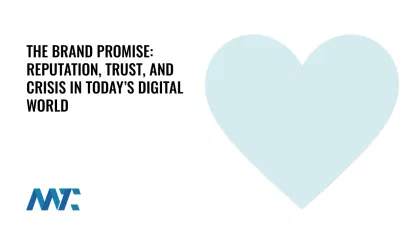
A friend of mine recently asked marketers what their definition of a brand was. I responded that a brand was the vision that I wanted to deliver to the customers I worked with.
He asked, So what’s a brand strategy?
I responded that it was how I communicated that vision. More important than a brand strategy, though, may be how you fulfill it.
The brand promise. I really like this visualization:
Every brand interaction is built on promises. Some are spoken outright in ads or sales pitches; others are implied in product quality, pricing, delivery times, or customer service. Whether your company is a global enterprise or a small business, your reputation hinges on a simple equation: promises kept equal trust and long-term loyalty, while promises broken lead to frustration, reputational damage, and—in today’s hyperconnected world—potential crisis.
Why Promises Matter More Today
In the analog era, a broken promise might frustrate a single customer, who might tell a few friends or colleagues. In today’s digital world, a broken promise can travel through online reviews, social media, or industry forums, amplifying the damage exponentially. Consumers are more empowered than ever, armed with instant access to competitor alternatives and platforms to broadcast their experiences.
What has changed is not just the scale of visibility but the speed at which perceptions shift. A delay in shipping, a misleading claim on your website, or an unkept service-level agreement can instantly become a trending complaint. Trust, once broken, becomes extraordinarily costly to repair.
Branding Is Every Touchpoint
Brand strategies extend far beyond campaigns, creative content, or advertisements. Every interaction is a brand promise in action:
- Your website implies usability and accuracy.
- Your customer service line implies accessibility and empathy.
- Your emails imply timely relevance.
- Your product experience implies consistency and value.
When companies think of branding only as promotion, they miss the larger truth: every employee, every system, and every process communicates a promise. Branding is no longer siloed; it is the holistic expression of how a business keeps or breaks trust.
The Cost of Broken Promises
The consequences of failing to deliver are sharper today:
- Reputation erosion: Negative reviews, ratings, and viral posts can overshadow years of brand-building.
- Customer churn: Even loyal customers are less forgiving when competitors offer seamless alternatives.
- Revenue loss: Trust is now directly tied to conversion rates, renewal rates, and upselling opportunities.
- Brand crises: A single unkept promise can escalate into a PR storm that requires costly damage control.
It’s important to note that customers often forgive mistakes if addressed with honesty, accountability, and corrective action. What they do not forgive is deception, neglect, or repeated failure.
Promises Kept as Reputation
On the flip side, consistently meeting or exceeding promises builds more than satisfaction—it builds advocacy. Companies that align expectations with delivery are rewarded not only with repeat customers but also with organic word-of-mouth and brand loyalty that money can’t buy.
In a crowded market where products and services often look alike, the consistency of promises kept becomes a brand’s most powerful differentiator.
Takeaways
- Audit your promises: Identify every explicit and implicit commitment your brand makes across ads, websites, service agreements, and even employee behavior.
- Align delivery with messaging: Don’t overpromise in your campaigns if your operations cannot deliver. Underpromising and overdelivering builds reputational capital.
- Monitor digital trust signals: Keep an active eye on reviews, social sentiment, and support tickets to identify when a promise may be slipping.
- Build recovery strategies: Mistakes will happen. Prepare clear communication and service recovery protocols that turn breakdowns into opportunities for renewed trust.
- Empower employees: Train and equip frontline staff to understand that they are brand ambassadors, each interaction reinforcing or undermining promises.
Branding is not just about what you say—it’s about what you do. Every promise you make, whether intentional or implied, sets an expectation. In today’s digital environment, where transparency and accountability are demanded, your reputation is built one kept promise at a time. Break them, and you court a crisis. Keep them, and you create a foundation of trust that becomes your most enduring competitive advantage.